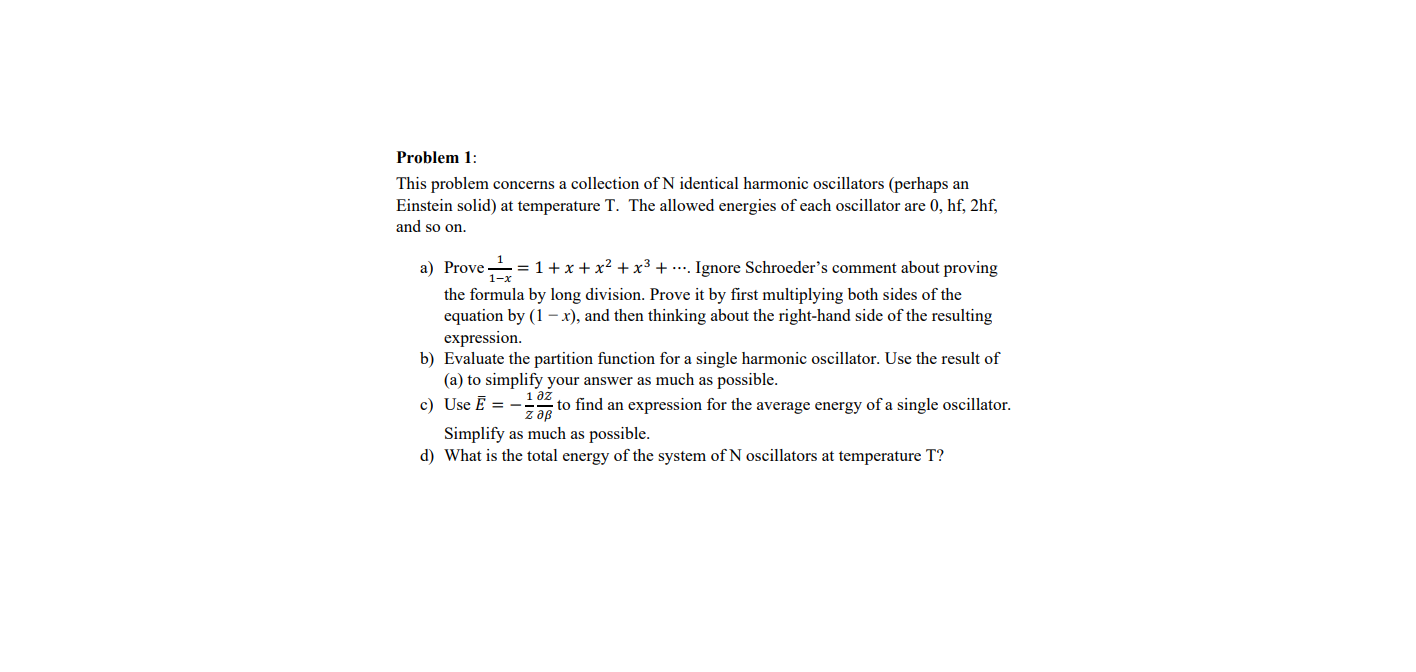Problem 1: This problem concerns a collection of N identical harmonic oscillators (perhaps an Einstein solid) at temperature T. The allowed energies of each oscillator are 0, hf, 2hf, and so on. a) Prove =1+x + x² + x³ + .... Ignore Schroeder's comment about proving 1-x the formula by long division. Prove it by first multiplying both sides of the equation by (1 – x), and then thinking about the right-hand side of the resulting expression. b) Evaluate the partition function for a single harmonic oscillator. Use the result of (a) to simplify your answer as much as possible. c) Use E = - дz to find an expression for the average energy of a single oscillator. z aB Simplify as much as possible. d) What is the total energy of the system of N oscillators at temperature T?
Problem 1: This problem concerns a collection of N identical harmonic oscillators (perhaps an Einstein solid) at temperature T. The allowed energies of each oscillator are 0, hf, 2hf, and so on. a) Prove =1+x + x² + x³ + .... Ignore Schroeder's comment about proving 1-x the formula by long division. Prove it by first multiplying both sides of the equation by (1 – x), and then thinking about the right-hand side of the resulting expression. b) Evaluate the partition function for a single harmonic oscillator. Use the result of (a) to simplify your answer as much as possible. c) Use E = - дz to find an expression for the average energy of a single oscillator. z aB Simplify as much as possible. d) What is the total energy of the system of N oscillators at temperature T?
Related questions
Question

Transcribed Image Text:Problem 1:
This problem concerns a collection of N identical harmonic oscillators (perhaps an
Einstein solid) at temperature T. The allowed energies of each oscillator are 0, hf, 2hf,
and so on.
a) Prove =1+x + x² + x³ + .... Ignore Schroeder's comment about proving
1-x
the formula by long division. Prove it by first multiplying both sides of the
equation by (1 – x), and then thinking about the right-hand side of the resulting
expression.
b) Evaluate the partition function for a single harmonic oscillator. Use the result of
(a) to simplify your answer as much as possible.
c) Use E = -
дz
to find an expression for the average energy of a single oscillator.
z aB
Simplify as much as possible.
d) What is the total energy of the system of N oscillators at temperature T?
Expert Solution
This question has been solved!
Explore an expertly crafted, step-by-step solution for a thorough understanding of key concepts.
This is a popular solution!
Trending now
This is a popular solution!
Step by step
Solved in 4 steps with 4 images
